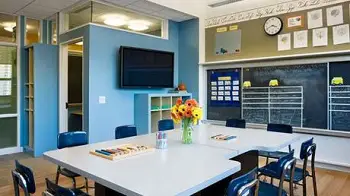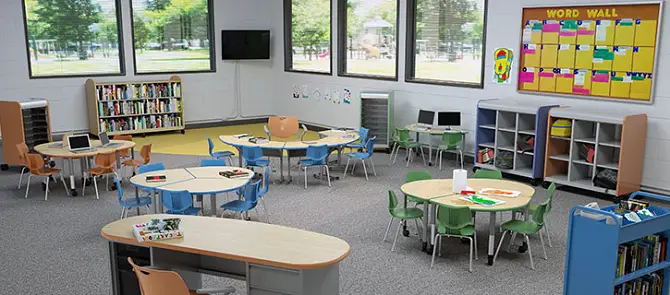Best Colors For Classroom
Best Colors For Classroom

You can boost your active learning with colors
Active learning is when all students participate actively in learning. Active learning is what teachers strive for. Our students learn best when we pay attention and engage them in our lessons. The colors you choose for your classroom can help you achieve the goal of getting all students engaged with active learning.
When planning out your room and thinking about the colors and decorations you’ll use, it is important to make sure that you don’t over-stimulate your students. Students can get distracted easily and find it hard to pay attention.
When choosing the colors for your classroom, look for options that will encourage your student to participate and help them retain the information you share. Because bright colors stimulate brain activity and memory, it is worth considering using them.
Yellow: A great choice for students that have trouble paying attention. The color yellow can be used to grab students’ attention and keep them engaged throughout lessons. Use yellow paper as a note page or other information to help your students. This is one way that you can capitalize on the positive effects of the yellow color. Consider adding yellow accents such as baskets and chair cushions to your classroom.
Green: Green may help students calm down. Green colors are relaxing and do not cause eye strain. Green can have a positive impact on your students so you will want to consider ways that it could be incorporated into classroom design. Find ways to include greenery near students’ desks to make them more focused on what they do at work. To create calmer spaces for students, you can add green accents to your classroom.
Orange: The addition of Orange to the diet can increase oxygen intake for our students. This can also be beneficial for their nervous systems, circulation, and immune system. This is why you can add orange to the classroom and improve students’ mood.
In this example, if the child is upset over something they saw at recess or has other issues, having more orange in their space might help them to move faster.
The Trending Right Now
COVID-19 Maintenance & Operations Furniture & Equipment Construction Facilities.
There are literally thousands to consider when building or renovating schools. It is common to overlook color and the colors used in classroom walls.
Bonnie Krims IACC (architectural color consultant) with Bonnie Krims Color Studio is Concord, Mass. “For budget purposes, a lot school don’t seek good information about color.” In many cases, the color selections are made by teachers, administrators or maintenance personnel. Some walls can end up looking white and this could cause understimulation. Krims adds that it used to be believed that the colorfuler the school the kids would enjoy, the better. Recent research shows that this is not the case. Many cases show that too much color (or too bright) can trigger overstimulation. It is important to balance, she states.
The International Association of Color Consultants – North America, (IACC-NA) states that a school’s environment can have a significant psycho-physiological effect on students. According to the IACC, “The right color selection is essential in protecting your eyesight and creating a learning environment that encourages you to study, as well as in maintaining your mental and physical health.”
Jill Pilaroscia, IACC, principal of Colour Studio, Inc., San Francisco, states that it’s important to choose the right color. “When you apply color, there is no magic formula or no single best way to do it,” she says. She says that the location, quality, character, and cultural backgrounds of students can all influence the selection process. However, it is important to remember some basic principles based on color psychology and visual ergonomics as well as the biological reaction to colors.

Colors In Elementary, Middle And Junior High Schools
Pilaroscia states that younger children are likely to be active so brighter and more warm color schemes can be used. “One problem is that a lot of teachers hang so many things on the walls that classrooms can become complete visual chaos,” she says. Students will be less anxious and more relaxed if their room is clean and well-organized.
Amy Wax, IACC, owner of Your Color Source Studios, Inc. in Montclair, N.J., agreed. You will find posters and artwork competing with your wall colors in many classrooms. Wax states, “These could lead to excessive stimulation. Which is one reason why the wall colour itself shouldn’t be too stimulating.” Wax recommends keeping the colors balanced for younger students. Wax suggests providing some stimulation while still allowing the children to have fun. It is important to choose warm colors so that they are able to welcome students and allow them to feel like the classroom has a welcoming environment. Her research shows that children in their younger years prefer blue, red, or yellow primary colors. Wax says that children can become anxious if they are too stimulated by a bright or strong color. For example, instead of bright yellow, you can consider a creamy yellow, which is warm and draws on a primary color, but is not overstimulating. “However, if you use too simple of a color, such as a beige, it can be understimulating,” she says.
One of the benefits of color is that it can help you focus. According to her, “You’d like to attract students’ attention to where they are located in the classroom, so the teacher could have a wall with a more bright color such as a yellow, or a red.”
Previous next >> This article first appeared in Spaces4Learning December 2013, issue School Planning & Management.
Whitepapers, Case Studies & eBooks Research & Reports webinars VRF Heating & Cooling Technology: Making the Grade for K-12 Schools. New Campus Reality: Meeting Emerging Delivery Demands With Contactless Technology. Disinfecting high-contact surfaces in classrooms to decrease student health risk Podcasts. Creating worry-free learning environments in education. Three Ways to Make College More Dynamic. Arizona State Envisions Space. Mitsubishi Electric Trane Heating and Air Conditioning Technology: Making The Grade for K12 Update
Type the numbers/letters that you see in bold.

The difference between hazel and green eyes
Answer: No matter the design of your environment, color can add value. According to the article, some colors can stimulate thought while others might deter concentration. The best background color is neutral, as you can accent it with other colors to add interest.
Question: Which are the most motivating colors for students, and why?
Answer: Individual color preferences are what students have. It is not the purpose of the learning center, classroom, or other space to encourage creativity.
Question: In what colors is a child most happy?
Answer: Although each child is able to associate with the chosen color, keeping it neutral and adding enhancements will ensure that your children have a positive experience.
Question: Does purple count as a positive choice for students in Special Education classes?
Answer: Working with ESE classes, I have found the use of neutral colors with lighter pastel accents work best.

A Classroom with Color
Add to my Account
The decor of classrooms can be anything from brightly colored preschool interiors to gray-terrazzo floors or white-washed blocks walls found in old high schools. Does color really matter when it comes to learning?
The current consensus is that what a student hears, feels and smells has a significant impact on his or her learning. Education’s latest trend is Brain-based Learning. This means learning by the senses.
“We know that color is one of the key elements in a stimulus-rich learning environment,” says Randy Fielding, chairman of Fielding Nair International, a Minneapolis planning and design firm specializing in education environments. Fielding is founder of DesignShare.com. This website provides information for educators and designers about learning environments. Fielding claims that colors are the best way to teach students.
He says that a well-designed palette can offer a wide range of colors, which includes calm blues and greens as well as more vibrant reds, oranges, or yellows. The combination of lighter tones with rich accent colors can create a sense of place. Functional color is a way to enhance learning and reduce eye strain. Higher contrasts tend to be more stimulating than lighter shades. This can encourage focus and improve student motivation. Research has shown that student absences are more likely to occur when students use monotonous colors.
Fielding states that creating environments conducive to learning is possible by using many colors with varying intensity. These include some shades used as culture-builders and way-finders in common areas.
He says that in colder climates, teachers and students will find warm and earthy colors inviting them to relax and enjoy collaborative and reflective learning. Students can enjoy a more relaxed environment in warm climates. Fielding also challenges some of the most common misconceptions about color’s influence. According to Fielding, red is not a stimulant. Too much soothing colour can cause the senses to dullen, instead of relax. It is important to avoid using bright primary colors that are long considered elementary-age favourites. Fielding says, “Children can be extraordinarily sensitive about nuances in light and color.” As for which specific colors work best, Fielding doesn’t discriminate. He says all colors are “good” and that they can be used by students. Learn more about learning color by visiting:
.Best Colors For Classroom
